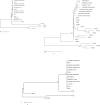Prevalence and genetic variability of occult hepatitis B virus in a human immunodeficiency virus positive patient cohort in Gondar, Ethiopia
- PMID: 33211768
- PMCID: PMC7704059
- DOI: 10.1371/journal.pone.0242577
Prevalence and genetic variability of occult hepatitis B virus in a human immunodeficiency virus positive patient cohort in Gondar, Ethiopia
Abstract
Background: Occult hepatitis B (OHB) is a major concern in HIV infected patients as it associates with a high risk of HBV reactivation and disease progression. However, data on the prevalence of OHB among HIV positive patients in Ethiopia is lacking. This study aims to determine the prevalence of OHB in HBV/HIV co-infected patients from Gondar, Ethiopia.
Methods: A total of 308 consented HIV positive patients were recruited from the University of Gondar Teaching Hospital, Ethiopia. Clinical and demographic data of the participants were recorded. Plasma was tested for HBsAg and anti-HBc using commercial assays (Abbott Architect). In HBsAg negative anti-HBc positive patient samples, total DNA was isolated and amplified using nested PCR with primers specific to HBV polymerase, surface and pre-core/core regions, followed by Sanger sequencing and HBV mutational analysis using MEGA 7.0.
Results: Of the total study subjects, 62.7% were female, median age 38.4 years, interquartile range (IQR): 18-68, and 208 (67.5%) had lifestyle risk factors for HBV acquisition. Two hundred and ninety-one study subjects were HIV+/HBsAg-, out of which 115 (39.5%) were positive for anti-HBc. Occult hepatitis B was detected in 19.1% (22/115) of anti-HBc positive HIV patients. HBV genotype D was the predominant genotype (81%) among OHB positive patients. Mutations associated with HBV drug resistance, HBV reactivation, and HCC risk were detected in 23% (5/22), 14% (3/22) and 45.5% (10/22) of patients, respectively.
Conclusion: This study found a high rate of occult hepatitis B in HIV patients. Further, high rates of mutations associated with HBV reactivation, drug resistance, and HCC risk were detected in these patients. These data highlighted the need for integrating OHB screening for proper management of liver diseases in HIV patients.
Conflict of interest statement
The authors have declared that no competing interests exist.
Figures


Similar articles
-
Characterization of occult hepatitis B virus infection among HIV positive patients in Cameroon.AIDS Res Ther. 2017 Mar 8;14(1):11. doi: 10.1186/s12981-017-0136-0. AIDS Res Ther. 2017. PMID: 28270215 Free PMC article.
-
Prevalence, risk factors and genotypes of hepatitis B infection among HIV-infected patients in the State of MS, Central Brazil.Braz J Infect Dis. 2014 Sep-Oct;18(5):473-80. doi: 10.1016/j.bjid.2014.01.005. Epub 2014 Mar 22. Braz J Infect Dis. 2014. PMID: 24662138 Free PMC article.
-
The prevalence of hepatitis B virus infection markers and socio-demographic risk factors in HIV-infected patients in Southern Brazil.Rev Soc Bras Med Trop. 2014 Sep-Oct;47(5):552-8. doi: 10.1590/0037-8682-0109-2014. Rev Soc Bras Med Trop. 2014. PMID: 25467254
-
Prevalence of occult HBV infection in Western countries.J Med Virol. 2020 Dec;92(12):2917-2929. doi: 10.1002/jmv.25867. Epub 2020 Jun 29. J Med Virol. 2020. PMID: 32275083 Review.
-
Hepatitis B virus infection in Indonesia.World J Gastroenterol. 2015 Oct 14;21(38):10714-20. doi: 10.3748/wjg.v21.i38.10714. World J Gastroenterol. 2015. PMID: 26478663 Free PMC article. Review.
Cited by
-
Epidemiology of occult hepatitis B and C in Africa: A systematic review and meta-analysis.J Infect Public Health. 2022 Dec;15(12):1436-1445. doi: 10.1016/j.jiph.2022.11.008. Epub 2022 Nov 12. J Infect Public Health. 2022. PMID: 36395668 Free PMC article.
-
High Prevalence of Hepatitis B Virus Infection Among People With HIV in Rural and Periurban Communities in Botswana.Open Forum Infect Dis. 2023 Jan 6;10(1):ofac707. doi: 10.1093/ofid/ofac707. eCollection 2023 Jan. Open Forum Infect Dis. 2023. PMID: 36686633 Free PMC article.
-
Prevalence of occult hepatitis B among HIV-positive individuals in Africa: A systematic review and meta-analysis.SAGE Open Med. 2022 Jan 30;10:20503121211072748. doi: 10.1177/20503121211072748. eCollection 2022. SAGE Open Med. 2022. PMID: 35127096 Free PMC article.
-
Molecular diversity of hepatitis B virus among pregnant women in Amhara National Regional State, Ethiopia.PLoS One. 2022 Nov 15;17(11):e0276687. doi: 10.1371/journal.pone.0276687. eCollection 2022. PLoS One. 2022. PMID: 36378635 Free PMC article.
-
Persistence and risk factors of occult hepatitis B virus infections among antiretroviral therapy-naïve people living with HIV in Botswana.Front Microbiol. 2024 May 9;15:1342862. doi: 10.3389/fmicb.2024.1342862. eCollection 2024. Front Microbiol. 2024. PMID: 38784816 Free PMC article.
References
-
- Paterlini P, Gerken G, Nakajima E, Terre S, d'Errico A, Grigioni W, et al. Polymerase chain reaction to detect hepatitis B virus DNA and RNA sequences in primary liver cancers from patients negative for hepatitis B surface antigen. New England Journal of Medicine. 1990. July 12;323(2):80–5. 10.1056/NEJM199007123230202 - DOI - PubMed
-
- Paterlini P, Driss F, Nalpas B, et al. Persistence of hepatitis B and hepatitis C viral genomes in primary liver cancers from HBsAg-negative patients: a study of a low-endemic area. Hepatology 1993;17: 20–29. - PubMed
MeSH terms
Substances
LinkOut - more resources
Full Text Sources
Medical

